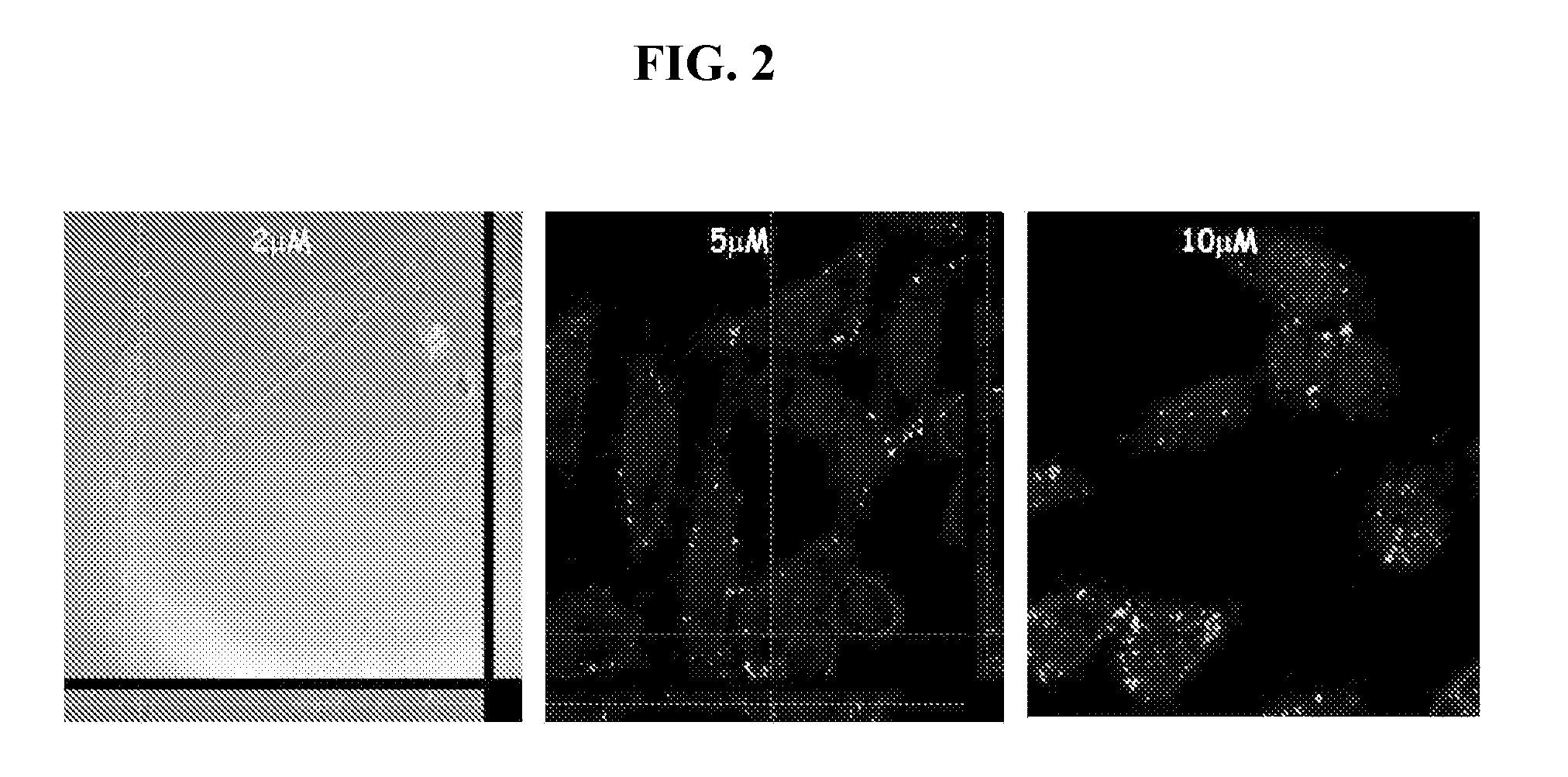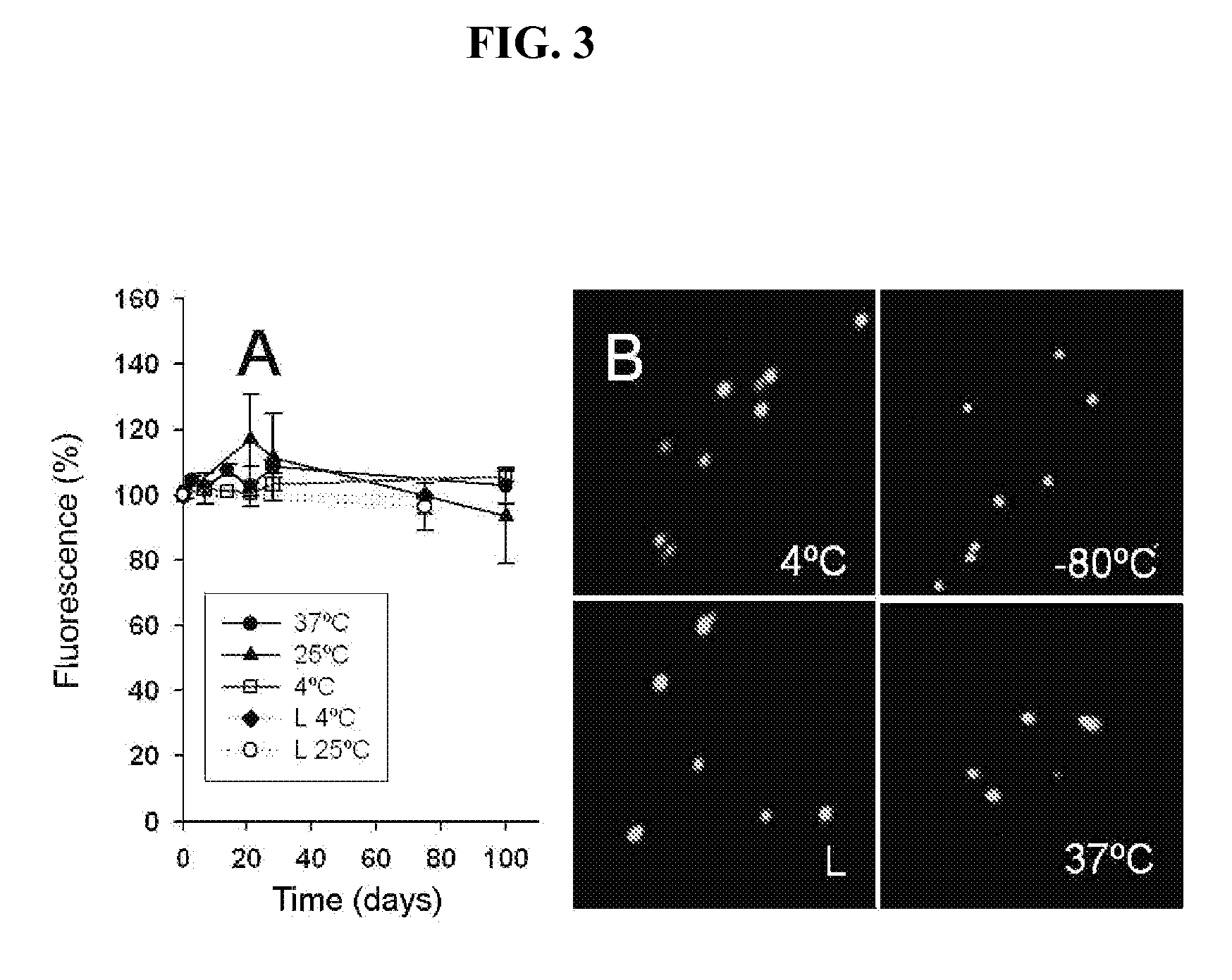Use of Inclusion Bodies as Therapeutic Agents
a technology of inclusion bodies and therapeutic agents, applied in the field of disease therapy, can solve the problems of low specificity and difficulty in producing proteins easily and quickly, poor recovery, and little room for speculation, and achieve the effect of efficient introduction of proteins
- Summary
- Abstract
- Description
- Claims
- Application Information
AI Technical Summary
Benefits of technology
Problems solved by technology
Method used
Image
Examples
example 1
Production and Characterization of IBs by Aggregation of GFP
[0081]This assay was performed to analyze if IBs produced in bacteria could be internalized by eukaryotic cells and if said internalization could inactivate the biological activity of the protein. To carry out this example IBs were produced based on the green fluorescent protein (GFP).
Materials and Methods
[0082]1.1 Production of Inclusion Bodies—Inclusion bodies (IBs) were produced in Escherichia coli MC4100 strains (WT regarding protein folding and degradation, araD139 Δ(argF-lac) U169 rpsL150 relA1 flbB5301 deoC1 ptsF25 rbsR) and in a strain derived thereof, JGT20 (deficient in the main chaperone DnaK, dnak756 thr::Tn10), hereinafter DnaK strain. These strains were transformed with the expression vector pTVP1GFP (ApR) (Garcia-Fruitós et al. (2005) “Aggregation as bacterial inclusion bodies does not imply inactivation of enzymes and fluorescent proteins” Microb. Cell. Fact. 4:27), encoding the green fluorescent protein (GF...
example 2
Production and Characterization of IBs by the Aggregation of Hsp70
[0092]In view of the data obtained in EXAMPLE 1, the inventors investigated if a therapeutic protein carried by IBs could show biological effects in the cells exposed to IBs. To that end, the human Hsp70 chaperone, a potent inhibitor of cell apoptosis (Gamido et al. (2003) “HSP27 and HSP70: potentially oncogenic apoptosis inhibitors” Cell Cycle 2: 579-584), among other activities of therapeutic value (Calderwood et al. (2005) “Message in a bottle: role of the 70-kDa heat shock protein family in anti-tumor immunity” Eur. J. Immunol. 35: 2518-2527), was chosen as a model protein.
Materials and Methods
[0093]2.1 Production of Inclusion Bodies—Following a protocol such as that described in section 1.1 of Example 1, duly adapted, inclusion bodies (IBs) were produced in strains of E. coli BL21 (DE3) transformed with a pReceiver-B01 commercial expression vector containing a N-His tag, a T7 promoter, and an ampicillin resistanc...
example 3
Dihydrofolate Reductase (DHFR) Inclusion Bodies (IB)
[0097]Dihydrofolate reductase converts dihydrofolate into tetrahydrofolate, a methyl group shuttle required for the de novo synthesis of purines, thymidylic acid, and certain amino acids. Deficiencies or alterations of DHFR have been linked to inherited spina bifida and neuronal tube defects, and to megaloblastic anemia. The average worldwide incidence of spina bifida is 1 case per 1000 births, but marked geographic variations occur. The highest rates are found in parts of the British Isles, mainly Ireland and Wales, where 3-4 cases of myelomeningocele per 1000 population have been reported, along with more than 6 cases of anencephaly (both live births and stillbirths) per 1000 population. The reported overall incidence of myelomeningocele in the British Isles is 2-3.5 cases per 1000 births. In France, Norway, Hungary, Czechoslovakia, Yugoslavia, and Japan, a low prevalence is reported: 0.1-0.6 cases per 1000 live births. In the Un...
PUM
| Property | Measurement | Unit |
|---|---|---|
| Therapeutic | aaaaa | aaaaa |
Abstract
Description
Claims
Application Information
 Login to View More
Login to View More - R&D
- Intellectual Property
- Life Sciences
- Materials
- Tech Scout
- Unparalleled Data Quality
- Higher Quality Content
- 60% Fewer Hallucinations
Browse by: Latest US Patents, China's latest patents, Technical Efficacy Thesaurus, Application Domain, Technology Topic, Popular Technical Reports.
© 2025 PatSnap. All rights reserved.Legal|Privacy policy|Modern Slavery Act Transparency Statement|Sitemap|About US| Contact US: help@patsnap.com



